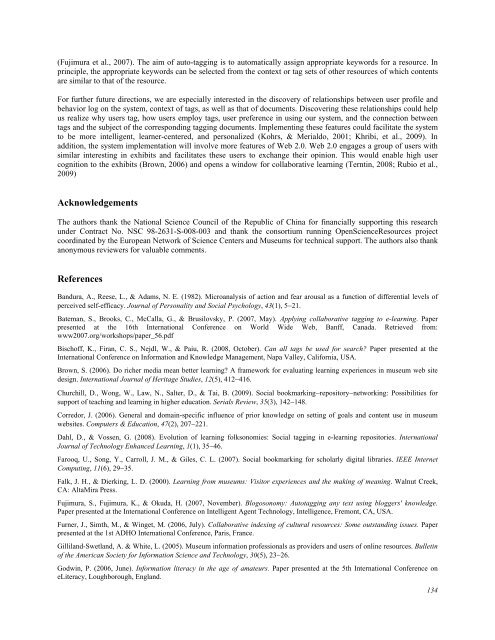October 2012 Volume 15 Number 4 - Educational Technology ...
October 2012 Volume 15 Number 4 - Educational Technology ...
October 2012 Volume 15 Number 4 - Educational Technology ...
Create successful ePaper yourself
Turn your PDF publications into a flip-book with our unique Google optimized e-Paper software.
(Fujimura et al., 2007). The aim of auto-tagging is to automatically assign appropriate keywords for a resource. In<br />
principle, the appropriate keywords can be selected from the context or tag sets of other resources of which contents<br />
are similar to that of the resource.<br />
For further future directions, we are especially interested in the discovery of relationships between user profile and<br />
behavior log on the system, context of tags, as well as that of documents. Discovering these relationships could help<br />
us realize why users tag, how users employ tags, user preference in using our system, and the connection between<br />
tags and the subject of the corresponding tagging documents. Implementing these features could facilitate the system<br />
to be more intelligent, learner-centered, and personalized (Kohrs, & Merialdo, 2001; Khribi, et al., 2009). In<br />
addition, the system implementation will involve more features of Web 2.0. Web 2.0 engages a group of users with<br />
similar interesting in exhibits and facilitates these users to exchange their opinion. This would enable high user<br />
cognition to the exhibits (Brown, 2006) and opens a window for collaborative learning (Terntin, 2008; Rubio et al.,<br />
2009)<br />
Acknowledgements<br />
The authors thank the National Science Council of the Republic of China for financially supporting this research<br />
under Contract No. NSC 98-2631-S-008-003 and thank the consortium running OpenScienceResources project<br />
coordinated by the European Network of Science Centers and Museums for technical support. The authors also thank<br />
anonymous reviewers for valuable comments.<br />
References<br />
Bandura, A., Reese, L., & Adams, N. E. (1982). Microanalysis of action and fear arousal as a function of differential levels of<br />
perceived self-efficacy. Journal of Personality and Social Psychology, 43(1), 521.<br />
Bateman, S., Brooks, C., McCalla, G., & Brusilovsky, P. (2007, May). Applying collaborative tagging to e-learning. Paper<br />
presented at the 16th International Conference on World Wide Web, Banff, Canada. Retrieved from:<br />
www2007.org/workshops/paper_56.pdf<br />
Bischoff, K., Firan, C. S., Nejdl, W., & Paiu, R. (2008, <strong>October</strong>). Can all tags be used for search? Paper presented at the<br />
International Conference on Information and Knowledge Management, Napa Valley, California, USA.<br />
Brown, S. (2006). Do richer media mean better learning? A framework for evaluating learning experiences in museum web site<br />
design. International Journal of Heritage Studies, 12(5), 412416.<br />
Churchill, D., Wong, W., Law, N., Salter, D., & Tai, B. (2009). Social bookmarkingrepositorynetworking: Possibilities for<br />
support of teaching and learning in higher education. Serials Review, 35(3), 142148.<br />
Corredor, J. (2006). General and domain-specific influence of prior knowledge on setting of goals and content use in museum<br />
websites. Computers & Education, 47(2), 207221.<br />
Dahl, D., & Vossen, G. (2008). Evolution of learning folksonomies: Social tagging in e-learning repositories. International<br />
Journal of <strong>Technology</strong> Enhanced Learning, 1(1), 3546.<br />
Farooq, U., Song, Y., Carroll, J. M., & Giles, C. L. (2007). Social bookmarking for scholarly digital libraries. IEEE Internet<br />
Computing, 11(6), 2935.<br />
Falk, J. H., & Dierking, L. D. (2000). Learning from museums: Visitor experiences and the making of meaning. Walnut Creek,<br />
CA: AltaMira Press.<br />
Fujimura, S., Fujimura, K., & Okuda, H. (2007, November). Blogosonomy: Autotagging any text using bloggers' knowledge.<br />
Paper presented at the International Conference on Intelligent Agent <strong>Technology</strong>, Intelligence, Fremont, CA, USA.<br />
Furner, J., Simth, M., & Winget, M. (2006, July). Collaborative indexing of cultural resources: Some outstanding issues. Paper<br />
presented at the 1st ADHO International Conference, Paris, France.<br />
Gilliland-Swetland, A. & White, L. (2005). Museum information professionals as providers and users of online resources. Bulletin<br />
of the American Society for Information Science and <strong>Technology</strong>, 30(5), 2326.<br />
Godwin, P. (2006, June). Information literacy in the age of amateurs. Paper presented at the 5th International Conference on<br />
eLiteracy, Loughborough, England.<br />
134

















